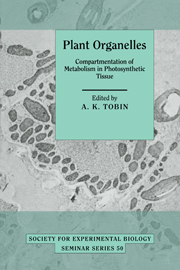Book contents
- Frontmatter
- Contents
- List of Contributors
- Preface
- Acknowledgements
- Metabolic interactions between organelles in photosynthetic tissue: a mitochondrial overview
- Metabolite transport in plant cells
- Metabolic interactions during photosynthetic and respiratory nitrogen assimilation in a green alga
- Carbon and nitrogen cycling between organdies during photorespiration
- Metabolic interactions between organelles in C4 plants
- Metabolic interactions in leaves of C3–C4 intermediate plants
- Metabolite compartmentation and transport in CAM plants
- Transport of H+, K+ and Ca2+ at the vacuolar membrane of plants
- Regulation of mitochondrial respiratory activity in photosynthetic systems
- Biosynthesis and assembly of the enzymes involved in lipid metabolism in plants
- The role of carnitine in plant cell metabolism
- Metabolic interactions of organelles in guard cells
- Transport of proteins into chloroplasts
- Metabolic interactions of organelles during leaf development
- Index
Metabolite compartmentation and transport in CAM plants
Published online by Cambridge University Press: 05 December 2011
- Frontmatter
- Contents
- List of Contributors
- Preface
- Acknowledgements
- Metabolic interactions between organelles in photosynthetic tissue: a mitochondrial overview
- Metabolite transport in plant cells
- Metabolic interactions during photosynthetic and respiratory nitrogen assimilation in a green alga
- Carbon and nitrogen cycling between organdies during photorespiration
- Metabolic interactions between organelles in C4 plants
- Metabolic interactions in leaves of C3–C4 intermediate plants
- Metabolite compartmentation and transport in CAM plants
- Transport of H+, K+ and Ca2+ at the vacuolar membrane of plants
- Regulation of mitochondrial respiratory activity in photosynthetic systems
- Biosynthesis and assembly of the enzymes involved in lipid metabolism in plants
- The role of carnitine in plant cell metabolism
- Metabolic interactions of organelles in guard cells
- Transport of proteins into chloroplasts
- Metabolic interactions of organelles during leaf development
- Index
Summary
Crassulacean acid metabolism (CAM) represents the third major subdivision of photosynthetic carbon assimilation types in green plants alongside the C3 and C4 pathways. As with the C4 pathway, the CAM pathway can be regarded as an ancillary biochemical mechanism, serving to provide CO2 at elevated concentrations for fixation in the Calvin cycle of C3 photosynthesis. In contrast to the C4 pathway, however, all the key biochemical components of carbon assimilation in CAM plants are to be found within individual mesophyll cells. CAM, in essence, is a cellular phenomenon, and this highlights the importance of regulating carbon flow between organelles at the subcellular level. The comparative biochemistry of CAM plants has been the subject of excellent reviews (Kluge & Ting, 1978; Osmond, 1978; Osmond & Holtum, 1981; Winter, 1985; Luttge, 1987; Griffiths, 1988; Leegood & Osmond, 1990). These sources can be consulted for detailed information on metabolic pathways and enzymic characteristics. We shall focus here on the significance of subcellular compartmentation for the control of carbon flow in the CAM pathway. While describing the metabolic interconversions characteristic of each compartment, our particular aim is to show how the regulation of metabolite flux between organelles is also fundamental to the carbon assimilation process in CAM plants. Our understanding of these transport processes is improving, but we are only just starting to unravel details of their molecular mechanisms.
- Type
- Chapter
- Information
- Plant OrganellesCompartmentation of Metabolism in Photosynthetic Tissue, pp. 141 - 168Publisher: Cambridge University PressPrint publication year: 1992
- 6
- Cited by



